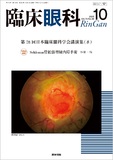Japanese
English
- 有料閲覧
- Abstract 文献概要
- 1ページ目 Look Inside
- 参考文献 Reference
要約 目的:小口病は常染色体潜性遺伝の疾患で,先天停在性夜盲の一種である。眼底は剝げかかった金箔様と呼ばれる特徴的反射を呈するが,長時間の暗順応後にそれが消失する水尾-中村現象が知られている。本邦で超広角走査型レーザー検眼鏡により水尾-中村現象を捉えた報告は少なく,今回筆者らは超広角走査レーザー検眼鏡により,3時間の暗順応前後で鮮明に水尾-中村現象を捉えられた症例を経験したので報告する。
症例:59歳,女性。家族歴に特記すべき所見はなかった。左眼の飛蚊症で近医眼科を受診したところ,両眼の網膜血管周囲に滲出斑様の所見を認め,精査加療のため群馬大学医学部附属病院眼科へ紹介された。
所見:初診時矯正視力は両眼とも1.2,眼圧は右14.5mmHg,左17.0mmHgであった。前眼部は問題なく,両眼とも軽度の皮質白内障を認めた。両眼底には広範囲に金箔様の反射がみられた。光干渉断層計では金箔様反射移行部にellipsoid zoneの不整を認めた。初診時より10年ほど前から夜盲,羞明の自覚があった。全視野網膜電図では,錐体反応は正常,桿体反応は消失型であった。以上から小口病を疑い,3時間の暗順応前後に超広角走査型レーザー検眼鏡を施行すると,水尾-中村現象を鮮明に捉えられた。
結論:超広角走査型レーザー検眼鏡で水尾-中村現象を捉えた症例を経験した。超広角走査型レーザー検眼鏡は同現象の観察に有用である。
Abstract Purpose:Oguchi disease is an autosomal recessive disorder of congenital stationary night blindness. The fundus shows a characteristic reflection called ‘gold leaf reflex’, which returns to normal after a long period of dark adaptation(Mizuo-Nakamura phenomenon). Since there have been few reports in Japan of the Mizuno-Nakamura phenomenon captured by ultra-wide-angle scanning laser ophthalmoscope, we decided to show a case of Oguchi disease fundus images before and after dark adaptation with ultra-wide-angle scanning laser ophthalmoscope.
Case:A 59-year-old woman. There were no significant findings in her family history and she had no close relatives. She visited a local ophthalmologist for floaters in her left eye and was referred to our hospital for further examination and treatment of retinal exudates found in both eyes.
Results:Her corrected visual acuity was 1.2 in both eyes at the initial examination, and the intraocular pressure was 14.5 mmHg in the right eye and 17.0 mmHg in the left eye. The anterior segment was clear and both eyes had mild cortical cataracts. Both fundi showed extensive gold leaf reflexes. On OCT, irregularities in the Ellipsoid zone were observed at the junction of the gold leaf reflex. The patient had a history of night blindness and photophobia for approximately 10 years. When a full-field electroretinogram was performed, the patient was diagnosed with Oguchi disease because the cone response was normal and the rod response was of the lost type. After three hours of dark adaptation, the Mizuno-Nakamura phenomenon was observed clearly with the ultra-wide-angle scanning laser ophthalmoscope.
Conclusions:We experienced a case in which the Mizuno-Nakamura phenomenon was captured using ultra-wide-angle scanning laser ophthalmoscope. The ultra-wide-angle scanning laser ophthalmoscope is useful for observing this phenomenon and following Oguchi disease.

Copyright © 2025, Igaku-Shoin Ltd. All rights reserved.


